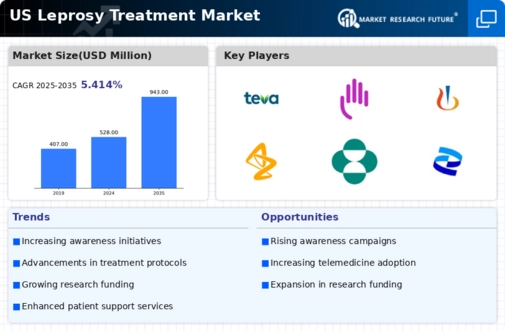Increased Focus on Rare Diseases
The leprosy treatment market is benefiting from a growing focus on rare diseases within the healthcare sector. As awareness of rare diseases increases, there is a corresponding rise in research funding and initiatives aimed at developing effective treatments. This trend is particularly relevant for leprosy, which is classified as a neglected tropical disease. The leprosy treatment market may experience growth as pharmaceutical companies and research institutions prioritize the development of therapies for rare diseases. Additionally, advocacy groups are increasingly raising awareness about leprosy, which could lead to greater public support and funding for research and treatment efforts. This heightened focus on rare diseases may ultimately enhance the treatment landscape for leprosy patients.
Rising Incidence of Leprosy Cases
The leprosy treatment market experiences a notable impact from the rising incidence of leprosy cases in the US. Recent data indicates that the number of reported cases has increased by approximately 10% over the past five years. This trend necessitates enhanced treatment options and resources, thereby driving demand within the leprosy treatment market. As healthcare providers become more vigilant in diagnosing and treating leprosy, the market is likely to expand. Furthermore, the increasing recognition of leprosy as a public health concern may lead to increased funding and support for treatment initiatives, further stimulating market growth. The rising incidence of leprosy cases underscores the need for effective treatment solutions, which could potentially lead to innovations in therapeutic approaches and patient care within the leprosy treatment market.
Government Initiatives and Funding
Government initiatives play a crucial role in shaping the leprosy treatment market. In recent years, federal and state governments have allocated substantial funding towards leprosy research and treatment programs. For instance, the US government has invested over $5 million annually to support leprosy-related health initiatives. These investments aim to improve access to treatment and enhance public awareness about the disease. Such funding not only facilitates the development of new treatment protocols but also encourages collaboration among healthcare providers, researchers, and non-profit organizations. As a result, the leprosy treatment market is likely to benefit from increased resources and improved healthcare infrastructure, ultimately leading to better patient outcomes and a more robust treatment landscape.
Technological Innovations in Treatment
Technological advancements are significantly influencing the leprosy treatment market. Innovations in diagnostic tools and treatment methodologies have the potential to enhance patient care and streamline treatment processes. For example, the introduction of molecular diagnostic techniques has improved the accuracy of leprosy diagnoses, allowing for earlier intervention. Additionally, advancements in drug formulation and delivery systems may lead to more effective treatment regimens. The leprosy treatment market is likely to see a surge in demand for these innovative solutions, as healthcare providers seek to adopt the latest technologies to improve patient outcomes. Furthermore, the integration of telemedicine in leprosy care could expand access to treatment, particularly in underserved areas, thereby driving market growth.
Global Collaboration in Research and Development
Collaboration among various stakeholders is becoming increasingly vital in the leprosy treatment market. Partnerships between governments, non-profit organizations, and private sector entities are fostering research and development efforts aimed at improving treatment options. These collaborations often lead to shared resources, knowledge, and expertise, which can accelerate the development of new therapies. For instance, joint initiatives may focus on clinical trials for novel treatments, enhancing the overall efficacy of leprosy care. The leprosy treatment market is likely to benefit from these collaborative efforts, as they can lead to innovative solutions and improved patient outcomes. Furthermore, such partnerships may also facilitate the dissemination of best practices and treatment protocols, ultimately strengthening the leprosy treatment market.

















Leave a Comment